How To Upload Binary Onto Hexiwear
Hexiwear
Side by side generation wearable IoT evolution platform designed to reduce time to marketplace. Comes in meaty form gene with on-board MCUs, BLE connectivity, sensors, OLED display, and battery. Open source software package includes embedded software, cellphone apps and cloud connectivity. Expandable with 200 additional click boards™.
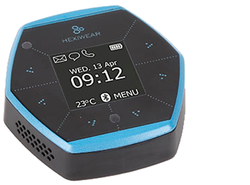
Quote:
Looking for mbed examples or applications to first programming your Hexiwear platform, jump directly to the HEXIWEAR CODE REPOSITORY
Overview¶
Hexiwear has been designed by MikroElektronika in collaboration with NXP to improve support developer projects past accelerating their time to market place, reducing their evolution and manufacturing costs and securing their migration from epitome to production. For only $49, this open-source reference-design for IoT/connected applications brings together everything developers need to blueprint their next IoT application in a very compact form cistron (2" 10 two").
Featuring more than than traditional MCU development platforms, the Hexiwear platform is ideal for connected applications, thanks to its power-efficient Kinetis K64F MCU featuring:
- ARM® Cortex®-M4 cadre;
- max frequency up to 120MHz;
- 1024KB Flash, 256KB RAM;
- many peripherals (16-flake ADCs, DAC, Timers);
- interfaces (USB Device Crystal-less, UART, SPI, I2C, I2S, SD-card).
Integration is as well a key feature of Hexiwear, with a Bluetooth Low Energy (BLE) SoC (Kinetis KW40z) and eight Sensors onboard:
- 6-centrality Accelerometer and Magnetometer combo (FXOS8700CQ);
- 3-centrality Gyroscope (FXAS21002CQ);
- Pressure sensor accurate upward to Distance sensing (MPL3115A2);
- Temperature and humidity philharmonic (HTU21D);
- Ambience light sensor (TSL2561);
- Optical Heart rate sensor (Maxim MAX30101).
Information technology also includes a 1.1" OLED color display and a 190mAh 2C Li-Po battery with a charger (MC34671) (encounter cake diagram below).
The Kinetis K64 MCU family remains fully software, hardware and evolution tool compatible with Kinetis MCUs, and existing NXP Freedom projects (using the FRDM-K64F Freedom platform) can be easily migrated to Hexiwear.
The docking station for Hexiwear allows developers to hands programme and debug their code (built-in USB Debug and Flash Programmer) and expand the board features with up to three click boards™ among a portfolio of more than than 200 references.
MCU Features¶
- Kinetis MK64FN1M0VDC12 in 121BGA
- Performance
- ARM® Cortex®-M4 32-flake core with DSP instructions and Floating Point Unit (FPU)
- 120 MHz max CPU frequency
- Memories and memory interfaces
- 1024 KB program flash retentiveness
- 256 KB RAM
- FlexBus external charabanc interface
- Organisation peripherals
- Multiple depression-power modes, low-leakage wake-up unit of measurement
- 16-channel DMA controller
- Clocks
- 3x Internal Reference Clocks: 32KHz, 4MHz and 48MHz
- 2x Crystal inputs: 3-32MHz (XTAL0) and 32kHz (XTAL32/RTC)
- PLL and FL
- Analog modules
- 2x 16-chip SAR ADCs up 800ksps (12-flake mode)
- 2x 12-bit DACs
- 3x Analog comparators
- Voltage reference 1.13V
- Advice interfaces
- 1x 10/100 Mbit/s Ethernet MAC controller with MII/RMII interface IEEE1588 capable
- 1x USB 2.0 Full-/Low-Speed Device/Host/OTG controller with embedded 3.3V/120mA Vreg, and USB device Crystal-less operation
- 1x Controller Expanse Network (Can) module
- 3x SPI modules
- 3x I2C modules. Support for upwards to 1 Mbit/s
- 6x UART modules
- 1x Secure Digital Host Controller (SDHC)
- 1x I2S module
- Timers
- 2x viii-channel Flex-Timers (PWM/Motor control)
- 2x 2-aqueduct FlexTimers (PWM/Quad decoder)
- 32-scrap PITs and 16-bit depression-ability timers
- Real-Time Clock (RTC)
- Programmable delay block
- Security and integrity modules
- Hardware CRC and random-number generator modules
- Hardware encryption supporting DES, 3DES, AES, MD5, SHA-1 and SHA-256 algorithms
- Operating Characteristics
- Voltage range: 1.71 to 3.vi Five
- Flash write voltage range: 1.71 to iii.6 V
Board Features¶
- Hexiwear Components
- Kinetis MK64FN1M0VDC12 - ARM® Cortex®-M4 @120MHz 32-flake main MCU with 1024KB Flash and 256KB RAM retentiveness
- FXOS8700CQ - half dozen-centrality combo Sensor Accelerometer and Magnetometer
- FXAS21002CQ - 3-axis Gyroscope
- FXAS21002CQ - pressure sensor accurate up to Altitude sensing
- HTU21D - combo temperature and Humidity
- TSL2561 - ambient light sensor and
- MAX30101 - optical Eye rate sensor
- W25Q64FVSSIG - 8MB/64Mbit Serial Flash memory
- 6 user capacitive/impact electrodes (controlled past KW40z Wireless SoC)
- RGB LED
- Vibration motor for haptic feedback
- Hexiwear Connectivity
- Kinetis MKW40Z160VHT4 - 2,4GHz Wireless SoC Bluetooth Depression-Free energy (BLE) v4.i (default) and 802.15.4 capable
- Up to 5x UARTs, 1x SPI, 2x I2Cs and 1x Can continued to Headers (multiplexed peripherals)
- I2S interface (pinout on Docking station)
- Extensions
- Micro SD-Card (Socket on Docking station)
- 3x mikro-bus sockets to combine click boards™ among a portfolio of 200 references (Headers on Docking station)
- Analog and Digital I/O (multiplexed peripherals)
- Up to two ADC 16-bit resolution with 8 Analog Pins connected to Headers
- Up to four timers with 10 PWM signals accessible from Headers
- Up to three Comparators with 6 Inputs
- Up to 31 MCU I/O Pins continued to Headers (3.3v, 25mA each, 100mA max total)
- Board power supply options (onboard v to three.3V regulator)
- Embedded 190 mAh 2C Li-Po battery
- Docking USB Debug port (charge enabled)
- Hexiwear USB port (charge enabled)
- OpenSDA USB Debug and Programming adapter (bachelor via the Docking Station)
- Several manufacture standard Debug interfaces (PEmicro, CMSIS-DAP, JLink)
- Drag-north-drib MSD Flash-programming
- Virtual USB to Serial Port
- Grade factor: 2in x 2in / 5.08cm x 5.08cm
- Software Development Tools
- mbed-Enabled(TM) (HDK, SDK, online development tools, community)
- Like shooting fish in a barrel to employ C/C++ SDK
- Many published libraries and projects
- Alternating offline options using NXP Kinetis Design Studio IDE (gratis compiler toolchain) and Kinetis SDK library/examples
- Supplier website: http://world wide web.hexiwear.com
- Status
- Available Now
Board Block Diagram¶
The graphic below gives an overview of the board features and the connection between the target MCU and the on-board components and connectors
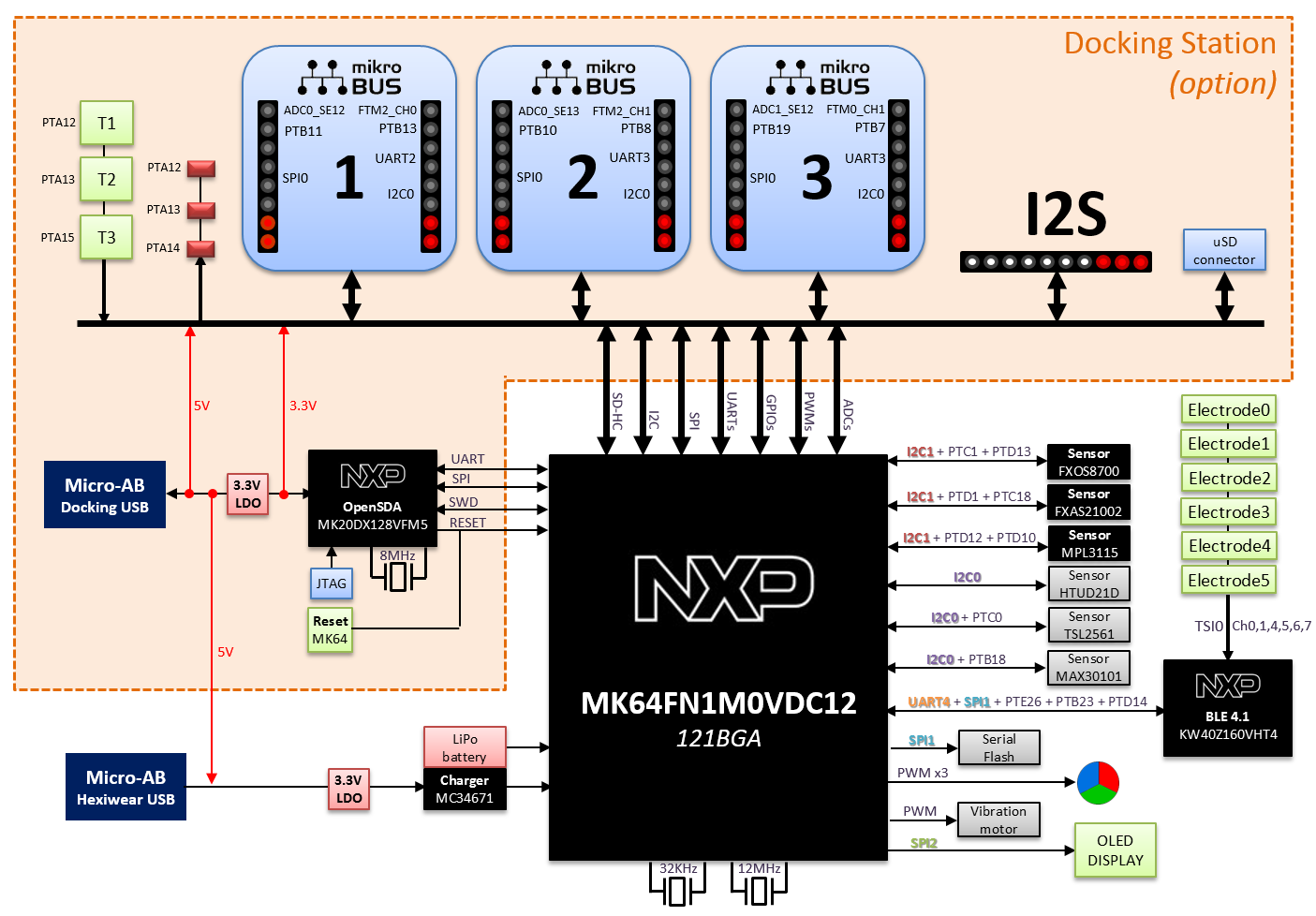
Lath Pinout¶
Component Pinout¶
Following figure indicates the Kinetis K64F signal connections with the board components (RGB LED, Sensors, Brandish, Memory...)
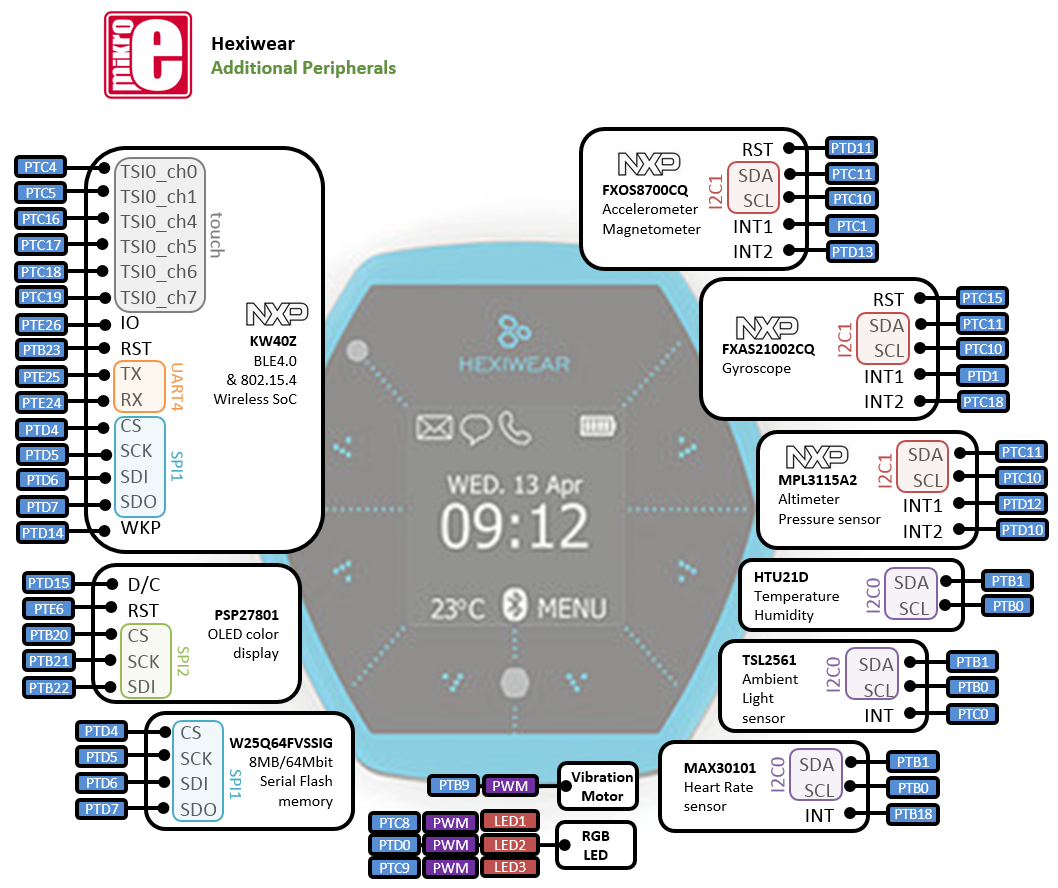
Docking headers enable up to 58-pins and give access to virtually of the Kinetis K64F signals via
- three Click module sockets
- one I2S header (not populated)
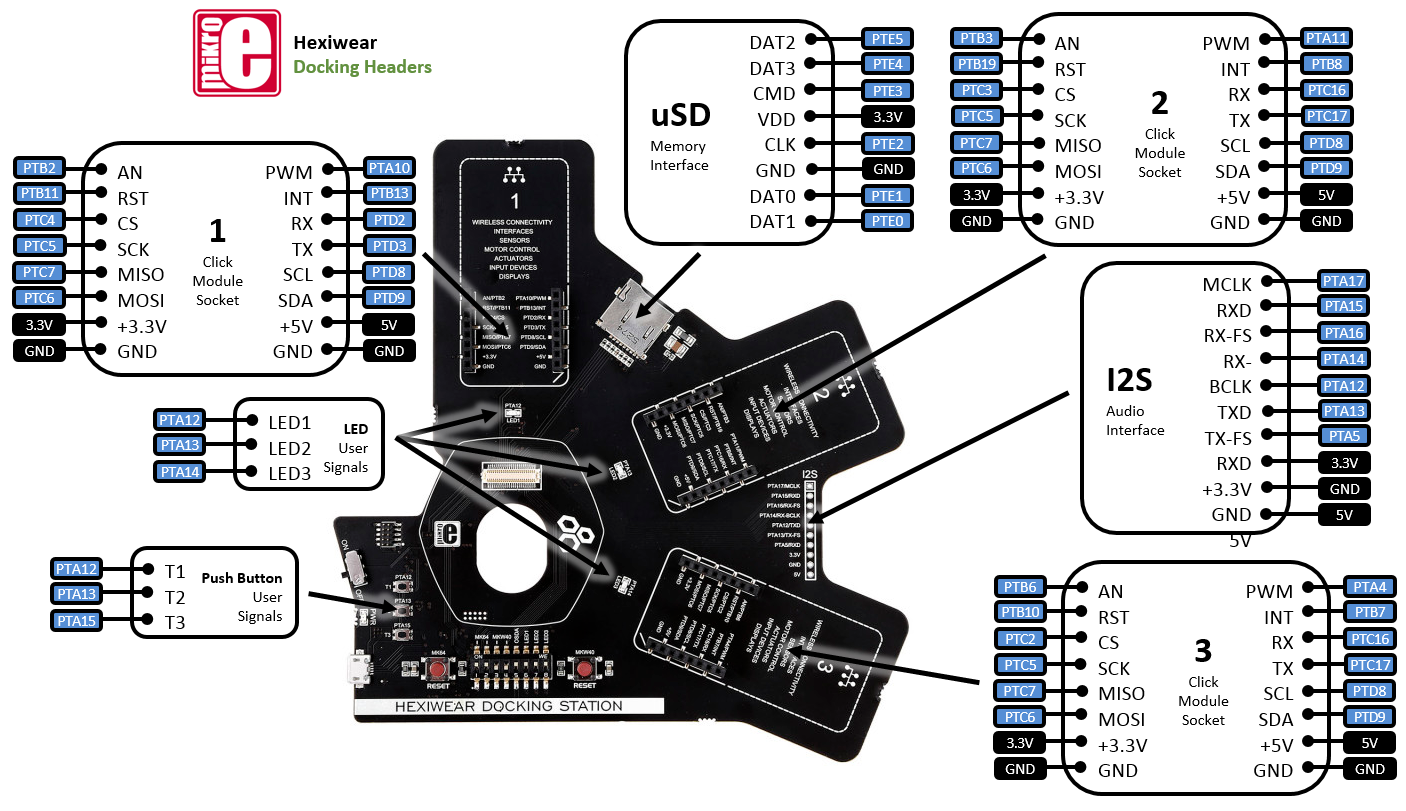
Of import Notes
Please notation that on this MCU in SPI Slave mode pins labeled MOSI comport as Slave Output and pins labeled MISO behave equally Slave Input. The terms MOSI (Chief Out Slave In) and MISO (Master In Slave Out) only utilise to Master mode.
Docking switches authorize user to select the microcontroller (K64F or KW40Z) to exist programmed/debugged, the onboard OpenSDA or external debugger and enable the I2S or the Push buttons.
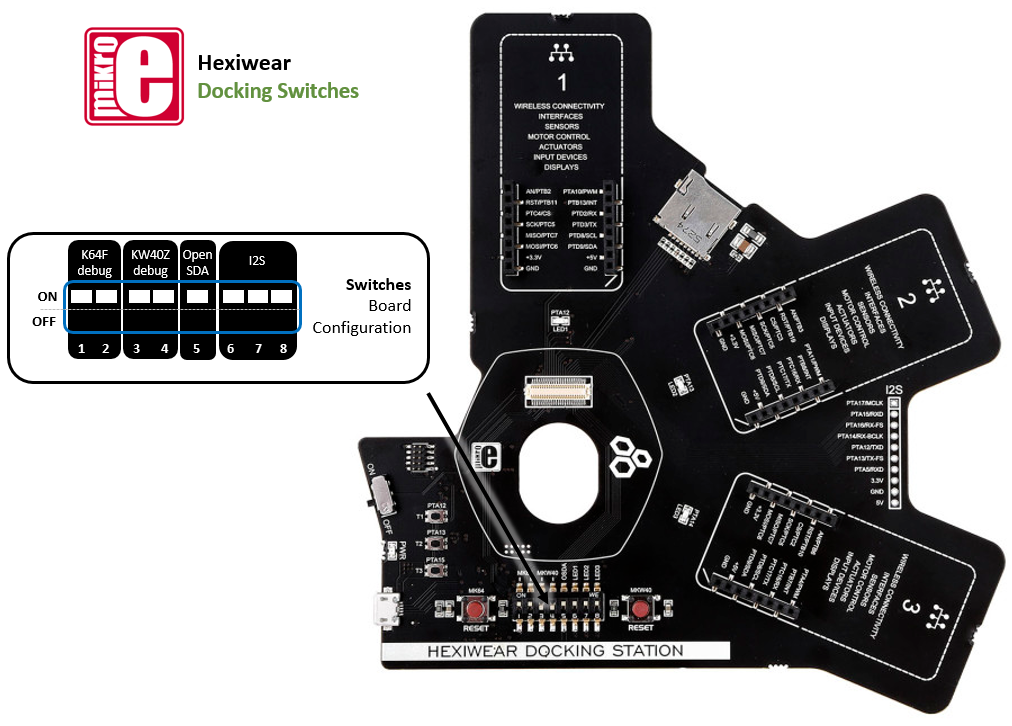
Hexiwear Docking Station is fully supported in the mbed Developer Platform with full access to the gratis tools and mbed SDK, providing experienced embedded developers with powerful and productive tools for building "proof-of-concepts". The pinout above shows the ordinarily used interfaces and their locations. Annotation that all the numbered pins (PT_XX) can also exist used as DigitalIn and DigitalOut interfaces.
Pivot names¶
- Hexiwear with Docking Signal available and pin-multiplexing
PC Configuration¶
The Docking station embeds (on the back) a controller, which emulates the latest ARM DAP-LINK debug interface, featuring MSD Flash programming, Debug and virtual Series Series port. You must connect your computer via the USB cable to the micro-USB port of the Docking station. Make sure that the PWR switch of the Docking station is set ON and the green PWR condition light volition come up on, indicating it has ability. The MSD bulldoze and the Debugger are automatically detected yet the Virtual Series port must be properly setup for your figurer. On Mac and Linux, this will happen by default. For Windows, yous demand to install a driver:
From a host PC to communicate with mbed you will need a terminal application. This allows Hexiwear via the micro-USB port of the Docking station to print to your PC screen, and for you to send characters back to your mbed.
- Terminals - Using Concluding applications to communicate between the Host PC and the Hexiwear via the micro-USB port of the Docking station.
Some last programs (e.g. TeraTerm) list the available series ports by proper name. Nonetheless, if you do need to know the identity of the serial port so that y'all can attach a final or an application to it:
| Windows | Mac | Linux | ||||
| Detect the identity of the COM port by opening ''Device Manager''. To do this navigate ''First -> Command Panel -> System -> Hardware -> Device Director''. | To find the device proper noun under Mac Os X, utilise the command ''ls /dev/tty.usbmodem*'' | To find the device name under Linux, use the control ''ls /dev/ttyACM*'' | ||||
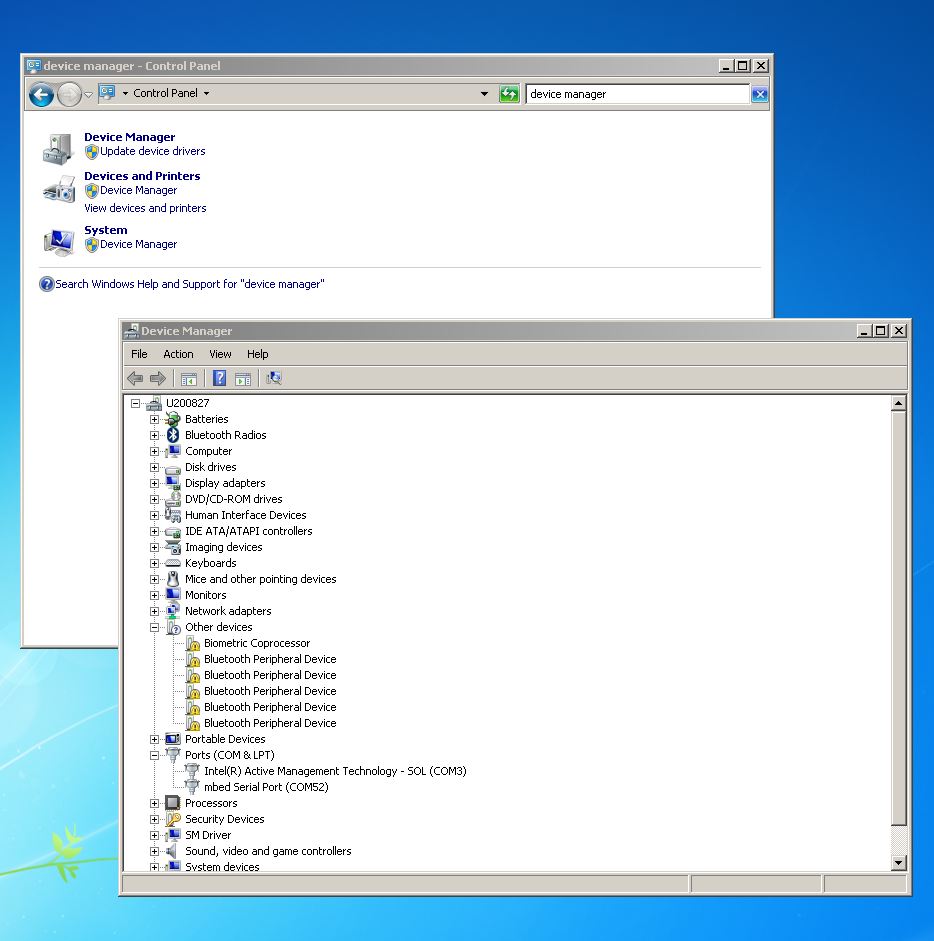 | 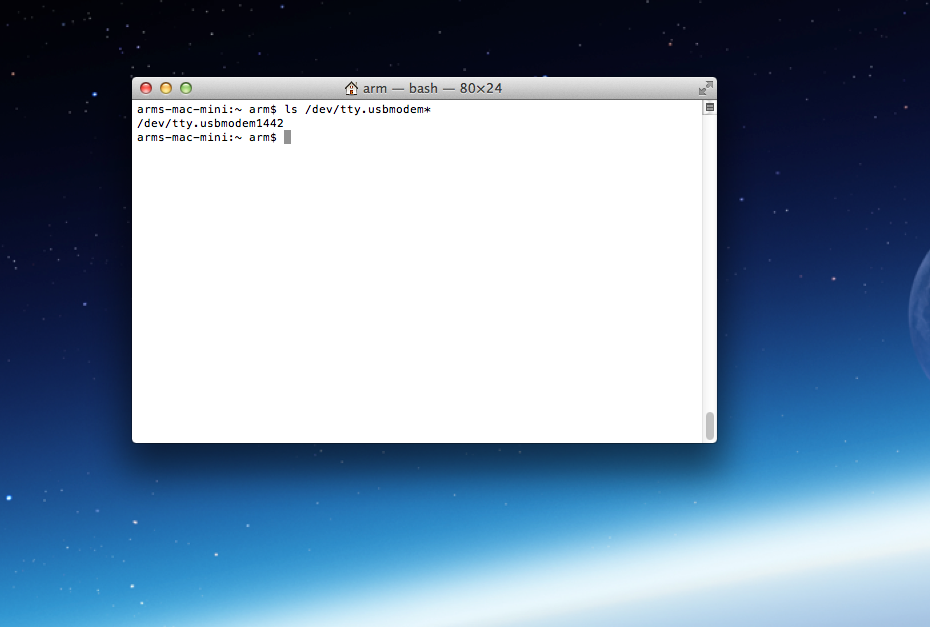 | 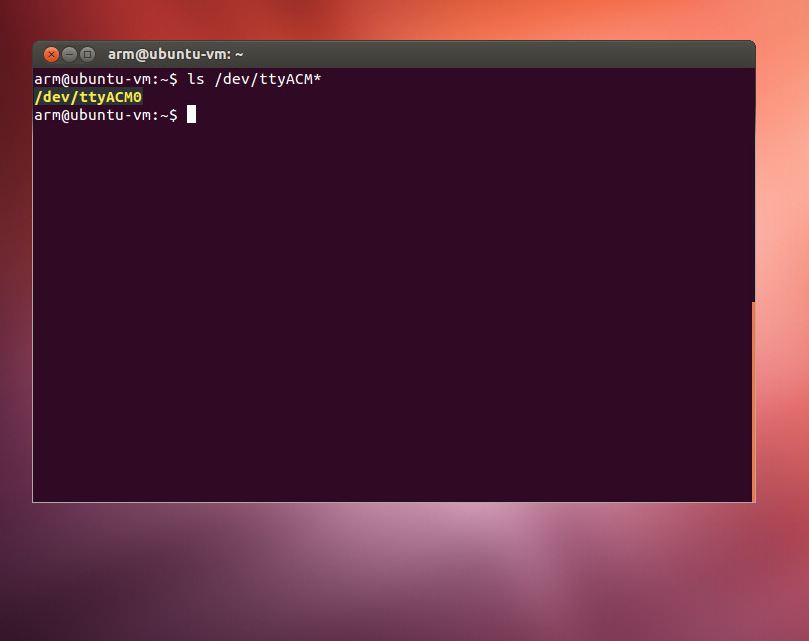 |
Get Started with mbed¶
one. First lath connection¶
Plug Hexiwear on the Docking station and connect the one stop of the USB cablevision to your computer and the other end to the micro-USB port of the Docking station. Make sure that the PWR switch of the Docking station is prepare ON and the green PWR status low-cal will come on, indicating it has power. Afterward a few seconds of activity, the PC will recognize the mbed Microcontroller equally a standard USB drive called "DAP-LINK".
two. Connect to mbed¶
Go to the new USB Bulldoze, and click MBED.HTM to open it in a web browser.
If you do not have an mbed account, cull "Signup", and create your mbed Account. Otherwise, log in with your established mbed username and password.
This will give y'all access to the website, tools, libraries and documentation.
Wink a project binary¶
1. Download a (.bin) to Hexiwear¶
Download the appropriate "Howdy World!" binary:
- MikroElektronika HEXIWEAR: HelloWorld_Hexi_K64F.bin
Note: the source code for this plan will exist seen in the next section.
Save the plan binary file to the DAP-LINK disc from your file explorer, just like you would with a normal USB deejay.

2. Press the Reset Push¶
When the Reset_K64F Push button located on the Docking station is pressed, the newest plan on the DAP-LINK bulldoze will be loaded in to the K64F microcontroller FLASH retentiveness.
When the program is has been loaded onto the K64F microcontroller, it volition then start it running.
three. Run Hullo World!¶
The K64F microcontroller is at present running the programme; Glimmer LED Cherry forever! If y'all reset the K64F microcontroller, or disconnect and reconnect the power, the program will simply restart.
4. Flash a new precompiled program¶
It is the newest plan on the K64F microcontroller that is run afterwards reset. We can therefore download a new program or overwrite an existing one to update the plan that will run.
Hexiwear manufacturing plant demo
The binary for the default project programmed in manufactory in Hexiwear memory is available for download at the stop of this page.
Open existing Projection¶
ane. Import the Program to your mbed compiler¶
Select Import Every bit Program
Choose Import Proper noun of your preference
Click on Import
2. Compile the Program¶
In the right console Program Workspace Select the plan you want to compile
Click on Compile in toolbar
If compilation ends successfully, you lot should see the comment Success! displayed in the Compile Output window available in the bottom and your web browser should download automatically the precompiled binary for the program.
3. Download a (.bin) to Hexiwear¶
Save the program binary file to the DAP-LINK drive from your file explorer, simply similar you would with a normal USB disk. The Status LED will flash as the PC writes the file to the Microcontroller disk.
4. Printing the Reset Push button¶
When the Reset_K64F Button located on the Docking station is pressed, the newest plan on the DAP-LINK drive will exist loaded in to the K64F microcontroller FLASH memory. The Condition LED volition flash every bit this happens. When the program has been loaded onto the K64F microcontroller, it will then kickoff it running.
5. Run the Program¶
The K64F microcontroller is at present running the plan; flashing LED1/Carmine located on Hexiwear forepart console forever! If you reset the K64F microcontroller, or disconnect and reconnect the power, the program volition merely restart.
Plan Examples
Congratulations, you have successfully compiled your starting time project example, you will observe more programme examples for the Hexiwear board available on the correct console of this page or at the Hexiwear code repository
Create new Projection¶
Follow the guide to creating your ain programs using the online compiler
- Create your own program
Technical Md¶
Hexiwear Board¶
- User'south Guide
- Schematic v106
Kinetis K64F MCU¶
- Data Sheet
- Reference Manual
- Errata
- AN4470 - Using Low-Power Modes with Kinetis MCUs
- AN5083 - Using DMA for pulse counting
- AN4373 - Cookbook for SAR ADC
- AN4381 - FlexTimer configuration
FXOS8700CQ 6-axis philharmonic Accelero and Magnetometer¶
- Data Sheet
- Errata
FXAS21002CQ 3-axis Gyroscope¶
- Data Sheet
MPL3115A2 Force per unit area sensor with Altimeter capabilities¶
- Data Sheet
HTU21D Temperature and Humidity sensor¶
- Information Sheet
TSL2561 Ambient light Sensor¶
- Data Sail
MAX30101 Optical Heart rate Sensor¶
- Data Sheet
KW40Z BLE v4.i and 802.fifteen.4 Wireless two.4GHz SoC¶
- Data Sheet
PSP27801 OLED color display¶
- Product Specification rev A0
- Solomon SSD1351 Graphical controller Datasheet rev1.three
W25Q64FVSSIG 8MB/64Mbit Serial Wink memory¶
- Data Sheet
Software Materials¶
Hexiwear Mill Program¶
- Hexiwear default/original demo
Hexiwear Interface Firmware / OpenSDA Application¶
- DAP-LINK Interface Firmware for the docking (updated version 24 April 2018)
Combining DAP-LINK debug, MSD flash programming and Serial features for both K64F and KW40Z MCUs
K64F Freedom Sensor Libraries and Examples¶
- FXOS8700Q - 6 Centrality combination Accelerometer / Magnetometer for eCompass
FXOS8700Q Driver Library and Example program
- eCompass - A basic eCompass using the on board FXOS8700Q
eCompass Library for Cortex-M4F and eCompass Example program
- Differential A2D - Library and example to employ the 16 Bit Differential A2D on the K64
Differential A2D Library for K64F and Differential A2D Case program
Hexiwear basic program examples¶
Hexiwear application examples¶
Import programHexi_BLE_Example
Hexiwear Bluetooth Low Energy Case. The device is configured to acquit as a sensor tag. This instance is to exist used with the Hexiwear mobile app on iOS and Android.
Import programHexi_OLED_Image_Example
Displays a total size paradigm (96px past 96px) on the Hexiwear OLED display then displays a smaller image (96px by 32px) on the lesser portion of the brandish.
Supported Mikroe Click modules¶
MIKROELEKTRONIKA introduced few years ago a new family called CLICK of meaty Connectivity and Sensor modules, much cheaper (starting $five) and smaller than Arduino shields. Up to now the Mikroe Click portfolio includes more than than 200 extension solutions!!
Please discover below the list of the Plan Examples tested with Hexiwear
User Interfaces¶
 Hexi Click Relay Example
Hexi Click Relay Example
Control two Relays using Bear upon electrodes and Brandish Relays status (instructions available).
 Hexi Click Buzzer Case
Hexi Click Buzzer Case
Play some tones with Buzzer using Bear on electrode to offset information technology and Brandish Buzzer status (instructions bachelor).
Assistance¶
Buy Now
Source: https://os.mbed.com/platforms/Hexiwear/
Posted by: williamsherant.blogspot.com

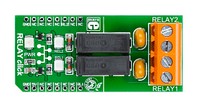
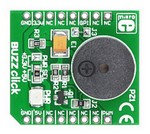
0 Response to "How To Upload Binary Onto Hexiwear"
Post a Comment